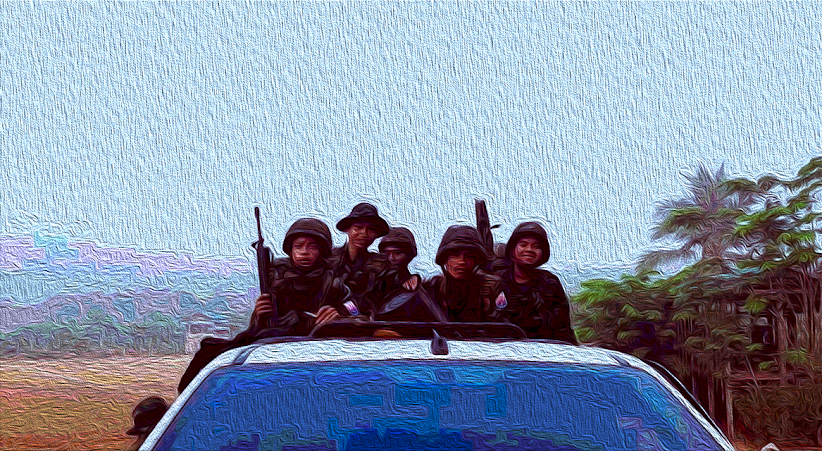Myanmar Spring Chronicle – View from September 24
(MoeMaKa, September 25, 2025)
Karen State front surges with manpower and arms; Kachin State front stalls
After holding the line for over a year, the coup military has, since last August, regrouped with thousands of troops, drones, and heavier weapons, and regained assistance from local border forces BGF and DKBA. They have been pressing continuously to seize Thingannyinaung strategic area, Myawaddy town, and then push on toward Lay Kay Kaw and Shwe Tao Kone.
For the KNU/KNLA, the situation in Karen State is not just a bilateral fight with the junta. Outcomes are also shaped by other Karen armed groups’ shifting positions, the border-trade routes and customs revenues, and the money from illegal online scams and gambling that operate along the Thai–Myanmar frontier—factors of nationalism, self-interest, and criminal economies that all influence the battlefield.
During the peak of Operation 1027 last year, several forces that had been “border guards” (BGF) effectively acted as independent armed groups protecting land for gambling and online fraud hubs near the border. That period coincided with repeated losses for the junta. At that time, the BGF led by Saw Chit Thu rebranded itself as the Karen National Army (KNA), and the DKBA also stood against the junta. Yet even when the resistance was strong last year, the KNU/KNLA could not take Myawaddy; the BGF positioned itself between the KNU/KNLA and the junta in a kind of “neither snake nor stick breaks” stance. By mid-2025, both the KNA (BGF) and DKBA were publicly saying they would assist the junta’s planned election.
The KNU/KNLA do not operate only in Karen State; they are also active in parts of Tanintharyi, eastern Bago, and Mon State. In Tanintharyi, the former KNDO breakaway now called KTLA is also based and operating. Areas such as Myawaddy, Thingannyinaung, Hpa-an, and Kawkareik/Asia Highway are crucial to the KNU both militarily and economically. The junta has exploited the shifts among other Karen groups and some recent battlefield gains to push offensives, and—for the first time in about two years—the army has re-established control over the Asia Highway link between Myawaddy and Kawkareik.
Noticing that armed groups in Karen State depend significantly on customs revenues from the cross-border trade through Myawaddy–Kawkareik–Kyone Doh, the junta has simultaneously tried to cut those revenue routes while advancing militarily, moving to pinch off customs corridors from two sides.
Taken together, this suggests that on the Karen front the KNU/KNLA’s near-term objective is likely to contain the junta rather than launch the broad offensives seen in 2024; conditions for a renewed wide push do not yet exist.
Bhamo front in Kachin State
By contrast, the Bhamo battle in Kachin State is now entering its ninth month. Both sides continue fighting with heavy casualties, but neither has been able to score a decisive gain: rather than a clean advance or retreat, each side holds parts of the town and clashes continue.
After the junta resupplied by river—bringing in weapons, supplies, and personnel—the military retook some sectors. Still, it lacks the strength to push the KIA out entirely. From the KIA side, given Bhamo’s strategic and mobilizational value, they are expected to keep up their defense and counterattacks.
While defending and making limited counter-takes around Bhamo, the junta has also opened offensives toward Hpakant and Loncai/Lonse north of Myitkyina. In recent months, columns numbering over a thousand have re-entered Hpakant, and battles there have re-ignited.
One clear aim of the junta’s push into Hpakant is to cut the KIA’s revenue streams. Despite the nationwide war since the 2021 coup—and frequent clashes around Hpakant—jade extraction has hardly ever stopped; even areas once left undisturbed, likened to “graveyards,” are now being rapidly dug up wherever quick money can be made. Taxes and “levies” from jade have been tapped by various actors to fund the civil war.
Beyond jade, rare-earth mining is another lucrative resource. The KIA captured much of Special Region (1)—an area rich in rare earths—over the past year. The junta has recently moved to attack that zone as well.
In short, the junta is prioritizing offensives against economically vital territories held by resistance forces, trying to sever revenue lifelines while applying military pressure.

